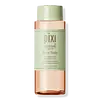What's inside
What's inside
 Key Ingredients
Key Ingredients

 Benefits
Benefits

 Concerns
Concerns

 Ingredients Side-by-side
Ingredients Side-by-side

Chamomilla Recutita Flower Water
MaskingCentaurea Cyanus Flower Water
Skin ConditioningCitrus Aurantium Amara Flower Water
MaskingRosa Damascena Flower Water
MaskingHamamelis Virginiana Leaf Water
AstringentWater
Skin ConditioningInositol
HumectantPanthenol
Skin ConditioningSodium Levulinate
Skin ConditioningSodium Anisate
AntimicrobialHydrolyzed Wheat Protein
Skin ConditioningGlycerin
HumectantCalendula Officinalis Extract
Skin ConditioningMalva Sylvestris Extract
AstringentSodium PCA
HumectantRosa Canina Bud Extract
Skin ConditioningAstilbe Chinensis Extract
Skin ConditioningCamellia Sinensis Extract
AntioxidantSalvia Officinalis Extract
AntimicrobialPhytic Acid
Sodium Benzoate
MaskingPotassium Sorbate
PreservativeBenzyl Alcohol
PerfumingChamomilla Recutita Flower Water, Centaurea Cyanus Flower Water, Citrus Aurantium Amara Flower Water, Rosa Damascena Flower Water, Hamamelis Virginiana Leaf Water, Water, Inositol, Panthenol, Sodium Levulinate, Sodium Anisate, Hydrolyzed Wheat Protein, Glycerin, Calendula Officinalis Extract, Malva Sylvestris Extract, Sodium PCA, Rosa Canina Bud Extract, Astilbe Chinensis Extract, Camellia Sinensis Extract, Salvia Officinalis Extract, Phytic Acid, Sodium Benzoate, Potassium Sorbate, Benzyl Alcohol
Water
Skin ConditioningGlycolic Acid
BufferingSodium Hydroxide
BufferingButylene Glycol
HumectantGlycerin
HumectantAloe Barbadensis Leaf Juice
Skin ConditioningHamamelis Virginiana Water
AstringentAesculus Hippocastanum Seed Extract
Skin ConditioningHexylene Glycol
EmulsifyingFructose
HumectantGlucose
HumectantSucrose
HumectantUrea
BufferingDextrin
AbsorbentAlanine
MaskingGlutamic Acid
HumectantAspartic Acid
MaskingHexyl Nicotinate
EmollientPanax Ginseng Root Extract
EmollientEthylhexylglycerin
Skin ConditioningDisodium EDTA
Biotin
AntiseborrhoeicPanthenol
Skin ConditioningPPG-26-Buteth-26
Skin ConditioningPEG-40 Hydrogenated Castor Oil
EmulsifyingPhenoxyethanol
PreservativeParfum
MaskingCaramel
Cosmetic ColorantBenzyl Benzoate
AntimicrobialCitral
PerfumingCitronellol
PerfumingCoumarin
PerfumingGeraniol
PerfumingHexyl Cinnamal
PerfumingHydroxycitronellal
PerfumingLimonene
PerfumingLinalool
PerfumingCI 14700
Cosmetic ColorantWater, Glycolic Acid, Sodium Hydroxide, Butylene Glycol, Glycerin, Aloe Barbadensis Leaf Juice, Hamamelis Virginiana Water, Aesculus Hippocastanum Seed Extract, Hexylene Glycol, Fructose, Glucose, Sucrose, Urea, Dextrin, Alanine, Glutamic Acid, Aspartic Acid, Hexyl Nicotinate, Panax Ginseng Root Extract, Ethylhexylglycerin, Disodium EDTA, Biotin, Panthenol, PPG-26-Buteth-26, PEG-40 Hydrogenated Castor Oil, Phenoxyethanol, Parfum, Caramel, Benzyl Benzoate, Citral, Citronellol, Coumarin, Geraniol, Hexyl Cinnamal, Hydroxycitronellal, Limonene, Linalool, CI 14700
 Reviews
Reviews

Ingredients Explained
These ingredients are found in both products.
Ingredients higher up in an ingredient list are typically present in a larger amount.
Glycerin is already naturally found in your skin. It helps moisturize and protect your skin.
A study from 2016 found glycerin to be more effective as a humectant than AHAs and hyaluronic acid.
As a humectant, it helps the skin stay hydrated by pulling moisture to your skin. The low molecular weight of glycerin allows it to pull moisture into the deeper layers of your skin.
Hydrated skin improves your skin barrier; Your skin barrier helps protect against irritants and bacteria.
Glycerin has also been found to have antimicrobial and antiviral properties. Due to these properties, glycerin is often used in wound and burn treatments.
In cosmetics, glycerin is usually derived from plants such as soybean or palm. However, it can also be sourced from animals, such as tallow or animal fat.
This ingredient is organic, colorless, odorless, and non-toxic.
Glycerin is the name for this ingredient in American English. British English uses Glycerol/Glycerine.
Learn more about GlycerinPanthenol is a common ingredient that helps hydrate and soothe the skin. It is found naturally in our skin and hair.
There are two forms of panthenol: D and L.
D-panthenol is also known as dexpanthenol. Most cosmetics use dexpanthenol or a mixture of D and L-panthenol.
Panthenol is famous due to its ability to go deeper into the skin's layers. Using this ingredient has numerous pros (and no cons):
Like hyaluronic acid, panthenol is a humectant. Humectants are able to bind and hold large amounts of water to keep skin hydrated.
This ingredient works well for wound healing. It works by increasing tissue in the wound and helps close open wounds.
Once oxidized, panthenol converts to pantothenic acid. Panthothenic acid is found in all living cells.
This ingredient is also referred to as pro-vitamin B5.
Learn more about PanthenolWater. It's the most common cosmetic ingredient of all. You'll usually see it at the top of ingredient lists, meaning that it makes up the largest part of the product.
So why is it so popular? Water most often acts as a solvent - this means that it helps dissolve other ingredients into the formulation.
You'll also recognize water as that liquid we all need to stay alive. If you see this, drink a glass of water. Stay hydrated!
Learn more about Water